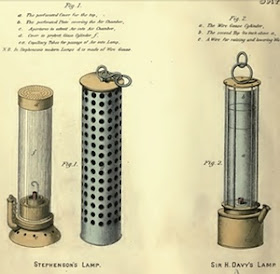Geordie Lamp
Grisú
Firedamp
1Cor.11:1
"Be ye followers of me, even as I also am of Christ."
George Stephenson 1781-1848, English Engineer..Stephenson began his
working life in coal mines and was one of the first people to realise
how steam power and railways could help the coal industry develop, He
became engineer to the pioneering Stockton and Darlington railway
company and drove the world's first steam-powered train in 1825. He
built the famous Rocket in 1829. It became the standard design that all
steam locomotives were based.
London's Top 10 : Science Museum - Puffing Billy Puffing Billy is the
world’s oldest remaining steam locomotive. It was built in England in
1813 and used to transport coal. George Stephenson’s famous 1829 Rocket,
the first locomotive engine to pull passenger carriages, is also on
display.
Geordie Lamp and Davy Lamp
Mine America's Coal - Norman Rockwell -
George Stephenson
In 1815, Stephenson was the engine-wright at the Killingworth Colliery in Northumberland and had been experimenting for several years with candles close to firedamp emissions in the mine. In August he ordered an oil lamp which was delivered on 21 October and tested by him in the mine in the presence of explosive gases. He improved this over several weeks with the addition of capillary tubes at the base so that it gave more light and tried new versions on 4 and 30 November. This was presented to the Philosophical and Literary Society of Newcastle on 5 December 1815.[1]
Although controversy arose between Stephenson's design and the Davy lamp (invented by Humphry Davy in the same year), Stephenson's original design worked on significantly different principles.[2] If the only way air could get to theflame was restricted (a baseplate pierced by a number of small-bore brass tubes was the usual way of doing this) and the lamp body above the flame lengthened, then the same amount of air could get to the flame, but would pass through the flow restriction at a velocity higher than the velocity of the flame in a mixture of firedamp (mostly methane) and air. This, then, prevented an explosive backblast that might light the surrounding air.
One advantage of Stephenson's design over Davy's was that if the proportion of firedamp became too high, his lamp would be extinguished, whereas Davy's lamp could become dangerously hot. This was illustrated in the Oaks colliery atBarnsley on 20 August 1857 where both types of lamp were in use.[3]
Stephenson's design used glass to surround the flame, which cut out less of the light than Davy's, where the gauze surrounded it.[4] But this also posed the danger of breakage in the harsh conditions of mineworking, a problem which was not resolved until the invention of safety glass. Stephenson tried several different designs in early years and later adopted Davy's gauze in preference to the tubes and it was this revised design that was used for most of the 19th century as the Geordie lamp.
The Geordie lamp continued to be used in the north-east of England through most of the 19th century, until the introduction of electric lighting.






No comments:
Post a Comment